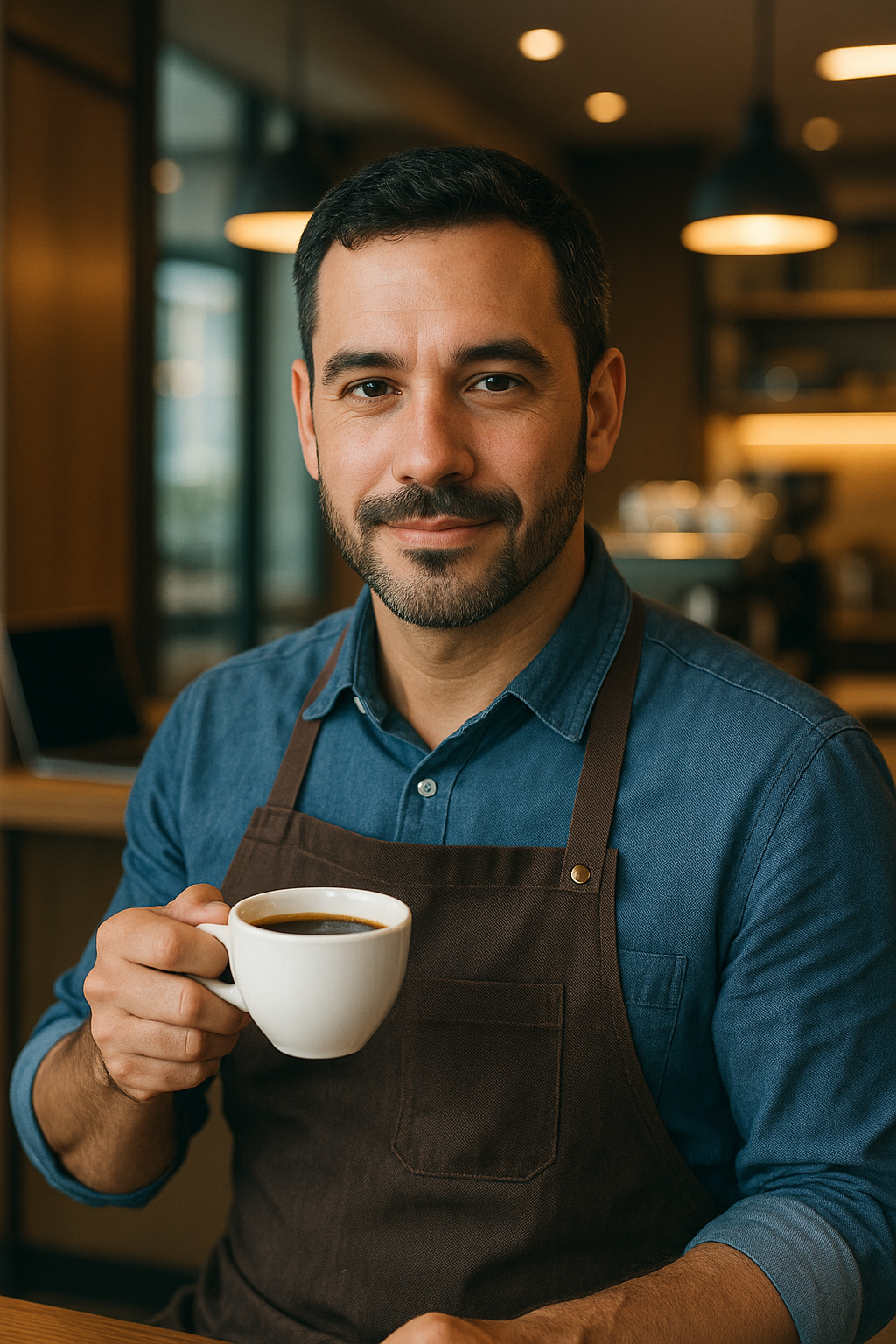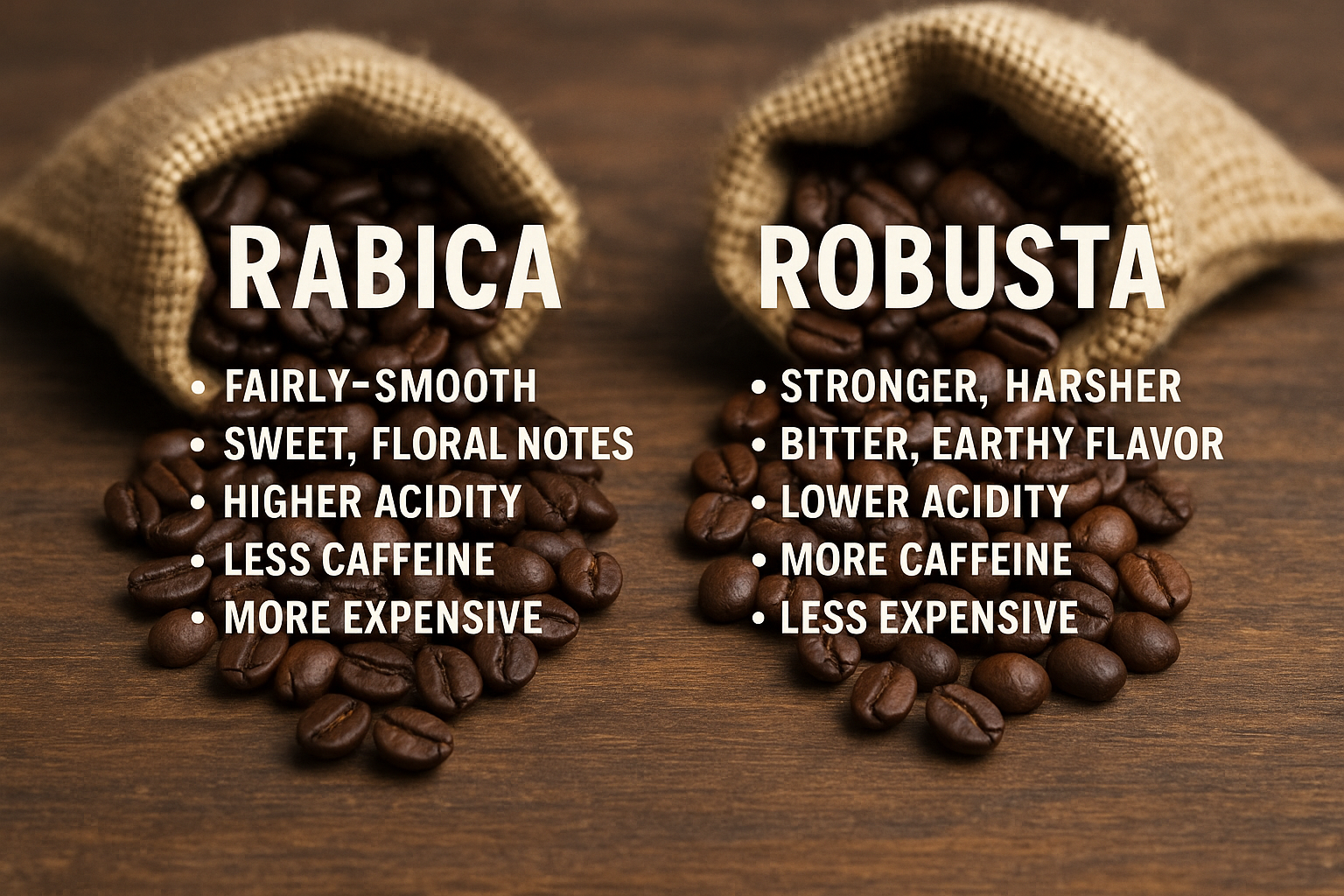When you’re buying coffee, whether at the supermarket or a specialty roaster, you’ll often see the words Arabica and Robusta on the packaging. But what do these terms actually mean?
How do they affect the taste, quality, and price of your coffee? In this article, we’ll break down the key differences between these two major coffee species, and help you decide which one is right for your brew.
The Two Main Species of Coffee
There are over 120 species of coffee plants, but only two dominate the global market:
- Coffea arabica (Arabica) – Accounts for about 60-70% of global coffee production.
- Coffea canephora (Robusta) – Makes up most of the remaining 30-40%.
Each has distinct characteristics in terms of flavor, growing conditions, caffeine content, and price. Let’s explore how they compare in more detail.
1. Taste and Flavor Profile
The most noticeable difference between Arabica and Robusta is taste.
- Arabica is known for its smooth, complex flavor. It typically has sweet, fruity, floral, or chocolaty notes. Depending on its origin and roast, it might taste like berries, citrus, caramel, or even jasmine.
- Robusta tends to be harsher and more bitter, with an earthy or woody taste. It often lacks the nuance and acidity that defines high-quality Arabica.
That’s why Arabica is preferred in the specialty coffee market, while Robusta is more commonly used in instant coffee, supermarket blends, or to add strength to espresso blends.
2. Caffeine Content
If your main concern is caffeine kick, Robusta wins by a large margin.
- Arabica: ~1.2–1.5% caffeine
- Robusta: ~2.2–2.7% caffeine
Caffeine contributes to coffee’s bitterness, which is one reason Robusta tastes stronger and sharper. It also acts as a natural insect repellent, making Robusta more resilient in the wild.
3. Acidity and Body
Coffee professionals often talk about acidity and body when describing a cup.
- Arabica has higher acidity (a good thing in coffee) and tends to feel lighter or silkier in the mouth.
- Robusta has a lower acidity and heavier, often grainy or oily mouthfeel.
For example, a lightly roasted Ethiopian Arabica may taste bright and tea-like, while a Vietnamese Robusta might feel thicker and leave a lingering bitter aftertaste.
4. Growing Conditions and Geography
Arabica is a more delicate plant. It requires:
- High altitudes (600–2000+ meters)
- Cooler temperatures (15–24°C / 59–75°F)
- Rich, well-drained soil
- More care and protection from disease
This makes it harder and more expensive to grow. Arabica plants are also more vulnerable to pests, particularly the coffee leaf rust fungus.
Robusta, on the other hand, is a hardier plant:
- Grows at lower altitudes (0–800 meters)
- Thrives in warmer climates (24–30°C / 75–86°F)
- More resistant to disease and pests
- Produces higher yields with lower maintenance
That’s why Robusta is often grown in large, industrial-scale plantations in countries like Vietnam, India, and Indonesia.
5. Price and Availability
Because Arabica is more difficult and expensive to grow, it usually costs significantly more than Robusta. However, there’s a range within each category.
- High-quality Arabica beans (e.g., Geisha from Panama or SL28 from Kenya) can command premium prices and are often used in single-origin or micro-lot offerings.
- Lower-grade Arabica might end up in cheaper blends, sometimes mixed with Robusta to reduce costs.
- Robusta beans are generally cheaper but have seen rising interest as specialty-grade Robusta emerges.
In recent years, some producers have been experimenting with high-end Robusta, focusing on improved processing methods and sustainable practices to give the beans a more refined flavor.
6. Uses in the Coffee Industry
Each type of bean has its role in the global market:
- Arabica:
- Filter and drip coffees
- Pour-overs and French press
- Specialty cafés and artisan blends
- Cold brew and nitro coffee
- Robusta:
- Instant coffee
- Commercial espresso blends (adds crema and body)
- Traditional Italian-style espresso
- Budget coffee brands and canned coffee drinks
In many espresso blends, especially those from Italy, Robusta is included to enhance crema, body, and caffeine content.
7. Health and Nutritional Aspects
Aside from caffeine levels, Robusta beans contain more chlorogenic acids (CGAs), which are antioxidants that may have health benefits like improving metabolism and reducing inflammation. However, higher CGA content also contributes to Robusta’s bitterness.
Arabica has more sugars and lipids, giving it a smoother taste but also making it more perishable. For health-conscious drinkers, the difference may not be huge unless you’re consuming large quantities.
8. Environmental Impact and Sustainability
Robusta’s resilience makes it more suitable for low-cost, large-scale farming, but it often involves monoculture practices and high use of fertilizers and pesticides.
Arabica farms—especially those geared toward specialty coffee—tend to be smaller and focus more on shade-grown, organic, or biodiversity-friendly methods. These practices often result in better long-term environmental impact, but they also come at a higher cost.
9. How to Choose Based on Your Preferences
Here’s a simple guide based on what you like in your coffee:
| Preference | Best Choice |
|---|---|
| Smooth, complex flavors | Arabica |
| Strong caffeine hit | Robusta |
| Rich crema in espresso | Blend with Robusta |
| Budget-friendly coffee | Robusta or blend |
| Floral, fruity, bright taste | High-altitude Arabica |
| Bitter, earthy, bold flavor | Robusta |
You can also try Arabica-Robusta blends to get the best of both worlds—smooth flavor with an extra kick and body.
Final Brew: Know Your Bean, Know Your Cup
Understanding the differences between Arabica and Robusta can transform the way you choose, brew, and enjoy your coffee. While Arabica may reign supreme in specialty circles, Robusta has its strengths and fans—especially for those who appreciate bold, intense flavors or need a jolt of caffeine.
The next time you pick up a bag of coffee, take a moment to check the label. Whether it’s a delicate Ethiopian heirloom Arabica or a bold Vietnamese Robusta, each has a story to tell—and a flavor worth discovering.

Marcelo Oliveira is a coffee enthusiast and content creator specializing in barista skills, brewing methods, equipment reviews, coffee-related health insights, and fascinating curiosities from the coffee world. With a deep passion for every step of the brewing process, he turns technical knowledge into accessible and engaging content for both beginners and seasoned coffee lovers. Marcelo’s goal is to help readers appreciate the full experience of coffee—from bean to cup.
